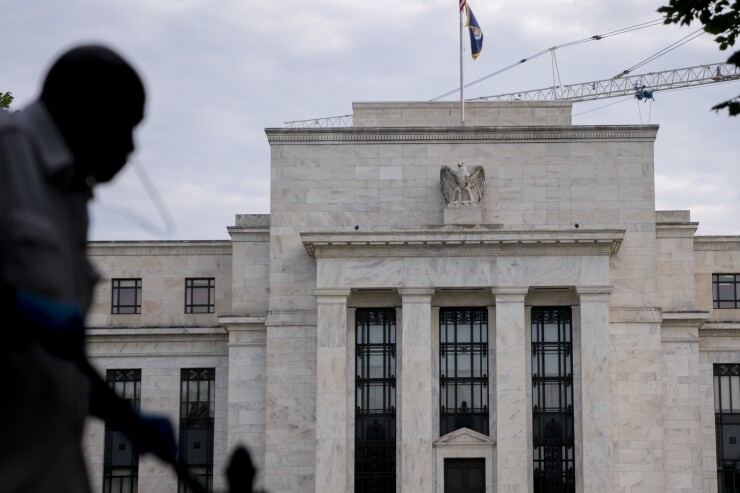For the first time during the two-month-old banking crisis, the Federal Reserve has taken a public enforcement action against a bank that saw its equity turn negative as a result of underwater bond investments.
But the question is: Is this a one-time thing, or more of a trend?
"They should use hammers more often, like this," said Bartlett Naylor, financial policy advocate at consumer advocacy group Public Citizen, adding that he welcomed the Fed "using its full suite of authorities to keep banks safe."
The
Du Quoin moved the deposits that flooded through its doors during the pandemic into securities, mostly municipal bonds. It had accumulated some $103 million in securities by the end of 2021 — or 73% of its assets.
That turned into trouble as the Fed hiked interest rates aggressively in 2022. Though the bank's equity is now back in the green — meaning its assets are now once again worth more than its liabilities — that was not the case last year.
The value of its bonds had plunged 18% as long-term rates hit their peak last year, a loss that left the bank with negative equity. It didn't help that Du Quoin State Bank appeared to have invested in longer-term bonds, said bank consultant Bert Ely. Longer-term bonds appear more lucrative since they generally pay more than shorter-term securities, but they also suffer more when rates go up on newer bonds since the buyer is stuck with low-yielding assets for longer.
"The farther out you go in the yield curve, the worse you're going to get whacked when rates get pushed up," Ely said.
The bank did not immediately respond to a request for comment.
Du Quoin State Bank's issues are far from typical, since many banks appeared to have done a far better job of managing their exposure to rising interest rates. But it was not the only one with significant exposures.
An
In February, the Fed's Board of Governors received a
The number of banks with issues have since declined as a fall in long-term rates has
The presentation flagged Silicon Valley Bank, which would fail weeks later, as a prime example of those risks. The Fed released the presentation
Asked about the presentation this week, Powell said the presentation did not flag the issue as "urgent or alarming" and that it did not mention the risk of a bank run putting extra pressure. He also noted that the presentation flagged steps that Fed supervisors were taking to address the issue.
At banks with less than $100 billion in assets, supervisors had stepped up their monitoring of institutions with low and declining equity levels, including targeted examinations at banks with negative equity. Bigger banks were facing more scrutiny of their exposures to interest rate increases and their impact on earnings, liquidity and capital, the presentation said.
Fed Vice Chairman for Supervision Michael Barr said last month that regulators need to reevaluate how "we supervise and regulate a bank's management of interest rate risk."
"While interest rate risk is a core risk of banking that is not new to banks or supervisors, SVB did not appropriately manage its interest rate risk, and supervisors did not force the bank to fix these issues quickly enough," Barr wrote in a report outlining conclusions from the review he conducted of the bank's supervisory issues.
The issues at Du Quoin State Bank were escalated to a public enforcement action, one of the more severe tools the regulator takes when looking to force improvements at a bank. Before making the issue public, the Fed
The enforcement action says the bank has "begun taking corrective action to address deficiencies that were identified in recent examinations" from the St. Louis Fed and Illinois bank regulators.
Regulators are blocking the bank from paying dividends without prior approval and are forcing it to submit plans for improving its capital, liquidity and investment policies. The bank must also submit a plan laying out "adequate guidelines and systems, including effective modeling, to measure, monitor, and control the Bank's interest rate risk," the enforcement action said.







